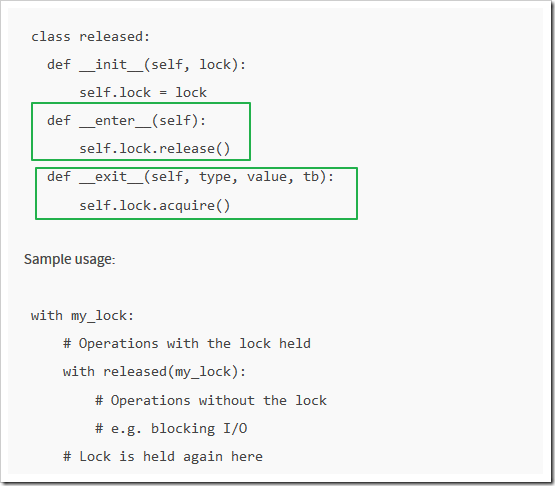python with語句的原理與用法詳解
本文實例講述了python with語句的原理與用法。分享給大家供大家參考,具體如下:
之前看到一篇博客說博主python面試時遇到面試官提問with的原理,而那位博主的博文沒有提及with原理,故有此文。
關(guān)于with語句,官方文檔中是這樣描述的:The with statement is used to wrap the execution of a block with methods defined by a context manager (see section With Statement Context Managers). This allows common try...except...finally usage patterns to be encapsulated for convenient reuse.
with_stmt ::= 'with' with_item (',' with_item)* ':' suite
with_item ::= expression ['as' target]
The execution of the with statement with one “item” proceeds as follows:
The context expression (the expression given in the with_item) is evaluated to obtain a context manager.
The context manager’s __exit__() is loaded for later use.
The context manager’s __enter__() method is invoked.
If a target was included in the with statement, the return value from __enter__() is assigned to it.
Note
The with statement guarantees that if the __enter__() method returns without an error, then __exit__() will always be called. Thus, if an error occurs during the assignment to the target list, it will be treated the same as an error occurring within the suite would be. See step 6 below.
The suite is executed.
The context manager’s __exit__() method is invoked. If an exception caused the suite to be exited, its type, value, and traceback are passed as arguments to __exit__(). Otherwise, three None arguments are supplied.
谷歌翻譯成中文就是:with語句用于使用由上下文管理器定義的方法來封裝塊的執(zhí)行(請參見使用語句上下文管理器一節(jié))。 這允許通用的try…except…finally使用模式被封裝以便于重用【這句話大概意思就是“with語句”類似于try…except…finally封裝之后的的情況】。
帶有一個“項目”的with語句的執(zhí)行過程如下:1.上下文表達(dá)式(在with_item中給出的表達(dá)式)被評估以獲得上下文管理器。【會區(qū)分類型來處理,如文件,進(jìn)程等都可以使用with語句】2.上下文管理器的__exit __()被加載供以后使用。【負(fù)責(zé)上下文的退出】3.上下文管理器的__enter __()方法被調(diào)用。【負(fù)責(zé)上下文的進(jìn)入】4.如果在with語句中包含目標(biāo),則將__enter __()的返回值分配給它。【如果with后面跟著as 對象(如with open() as f),那么此對象獲得with上下文對象的__enter__()的返回值,(附:應(yīng)該是類似操作數(shù)據(jù)庫時的連接對象和游標(biāo)的區(qū)別)】
注意with語句保證,如果__enter __()方法返回時沒有錯誤,那么將始終調(diào)用__exit __()。 因此,如果在分配給目標(biāo)列表期間發(fā)生錯誤,它將被視為與套件內(nèi)發(fā)生的錯誤相同。 請參閱下面的第6步。
5.該套件已執(zhí)行。【意思就是語句體中的過程執(zhí)行完畢,執(zhí)行完畢就到第六步--調(diào)用__exit__()來退出】6.上下文管理器的__exit __()方法被調(diào)用。 如果異常導(dǎo)致套件退出,則其類型,值和回溯作為參數(shù)傳遞給__exit __()。 否則,將提供三個無參數(shù)。
關(guān)于退出返回值:
If the suite was exited due to an exception, and the return value from the __exit__() method was false, the exception is reraised. If the return value was true, the exception is suppressed, and execution continues with the statement following the with statement.
If the suite was exited for any reason other than an exception, the return value from __exit__() is ignored, and execution proceeds at the normal location for the kind of exit that was taken.
中文:如果套件由于異常而退出,并且__exit __()方法的返回值為false,則會重新對異常進(jìn)行重新評估。 如果返回值為true,則異常被抑制,并繼續(xù)執(zhí)行with語句后面的語句。
如果套件由于除了異常之外的任何原因而退出,則__exit __()的返回值將被忽略,并且執(zhí)行將在正常位置繼續(xù)進(jìn)行。
意思就是:
如果是異常退出,那么會返回false,(根據(jù)文檔中的exit的描述“that __exit__() methods should not reraise the passed-in exception; this is the caller’s responsibility.”,大概意思就是exit()不會處理異常,會重新拋出異常拋出給外面,由調(diào)用者處理,因為這是調(diào)用者的責(zé)任)
如果返回 True,則忽略異常,不再對異常進(jìn)行處理【(在exit內(nèi)部處理完異常后,可以讓”__exit__()”方法返回True,此時該異常就會不會再被拋出,with會認(rèn)為它的執(zhí)行體沒有發(fā)生異常)】
(with會識別返回值,根據(jù)返回值來處理,如果是False,那么with會將執(zhí)行體中的異常拋出,如果是True,那么with會認(rèn)為沒有發(fā)生異常(忽略異常),而繼續(xù)執(zhí)行外面的語句,但由于內(nèi)部調(diào)用的了__exit__(),所以在異常之后的語句是不會運行的)
附上一個文檔中提供的一個關(guān)于with中使用鎖的例子:

import timeclass myContextDemo(object): def __init__(self,gen): self.gen = gen def __enter__(self): print('enter in ') return self.gen def __exit__(self, exc_type, exc_val, exc_tb):#exc_type是exception_type exc_val是exception_value exc_tb是exception_trackback print('exit in ') if exc_type is None:#如果是None 則繼續(xù)執(zhí)行 print('None:',exc_type, exc_val, exc_tb) else: #異常不為空時執(zhí)行,這一步,如果with語句體中發(fā)生異常,那么也會執(zhí)行 print('exception:', exc_type, exc_val, exc_tb) print('all done')if __name__=='__main__': gen=(i for i in range(5,10)) G=myContextDemo(gen) with G as f : print('hello') for i in f: print(i,end='t') #測試1:執(zhí)行體中發(fā)生異常 raise Exception('母雞啊') print('main continue')
結(jié)果顯示:
1.拋出異常后,后面main continue不再執(zhí)行
2.__exit__()中的else會執(zhí)行
測試2:當(dāng)else中強(qiáng)制返回為True時:import timeclass myContextDemo(object): def __init__(self,gen): self.gen = gen def __enter__(self): print('enter in ') return self.gen def __exit__(self, exc_type, exc_val, exc_tb):#exc_type是exception_type exc_val是exception_value exc_tb是exception_trackback print('exit in ') if exc_type is None:#如果是None 則繼續(xù)執(zhí)行 print('None:',exc_type, exc_val, exc_tb) else: #異常不為空時執(zhí)行,這一步,如果with語句體中發(fā)生異常,那么也會執(zhí)行 print('exception:', exc_type, exc_val, exc_tb) print('all done') return True #這里如果返回true可以看到發(fā)生異常后,main continue可以執(zhí)行 #即,如果exc_type是true,那么會繼續(xù)執(zhí)行,實際上,也可以在這里處理一下異常再返回trueif __name__=='__main__': gen=(i for i in range(5,10)) G=myContextDemo(gen) with G as f : print('hello') for i in f: print(i,end='t') raise Exception('母雞啊') # print('continue')#這里不會執(zhí)行 print('main continue')
結(jié)果顯示:
1.返回True之后,with會忽略異常,繼續(xù)執(zhí)行,所以這里“main continue”能執(zhí)行
2.即使忽略異常,在with體中異常之后的語句依舊不會執(zhí)行
附:理論上可以在返回True之前處理一下異常
PS:如果大家想要了解得更詳細(xì),可以自己嘗試去讀一下官方文檔。
附上關(guān)于with語句的詳細(xì)介紹官方文檔:https://www.python.org/dev/peps/pep-0343/
更多關(guān)于Python相關(guān)內(nèi)容感興趣的讀者可查看本站專題:《Python文件與目錄操作技巧匯總》、《Python文本文件操作技巧匯總》、《Python數(shù)據(jù)結(jié)構(gòu)與算法教程》、《Python函數(shù)使用技巧總結(jié)》、《Python字符串操作技巧匯總》及《Python入門與進(jìn)階經(jīng)典教程》
希望本文所述對大家Python程序設(shè)計有所幫助。
相關(guān)文章:
1. Django中的AutoField字段使用2. Django ORM實現(xiàn)按天獲取數(shù)據(jù)去重求和例子3. 解決docker與vmware的沖突問題4. IntelliJ Idea 2020.1 正式發(fā)布,官方支持中文(必看)5. IntelliJ IDEA設(shè)置自動提示功能快捷鍵的方法6. asp.net core應(yīng)用docke部署到centos7的全過程7. Java 3D的動畫展示(Part1-使用JMF)8. Python基于jieba, wordcloud庫生成中文詞云9. 如何在vue3.0+中使用tinymce及實現(xiàn)多圖上傳文件上傳公式編輯功能10. 刪除docker里建立容器的操作方法

 網(wǎng)公網(wǎng)安備
網(wǎng)公網(wǎng)安備